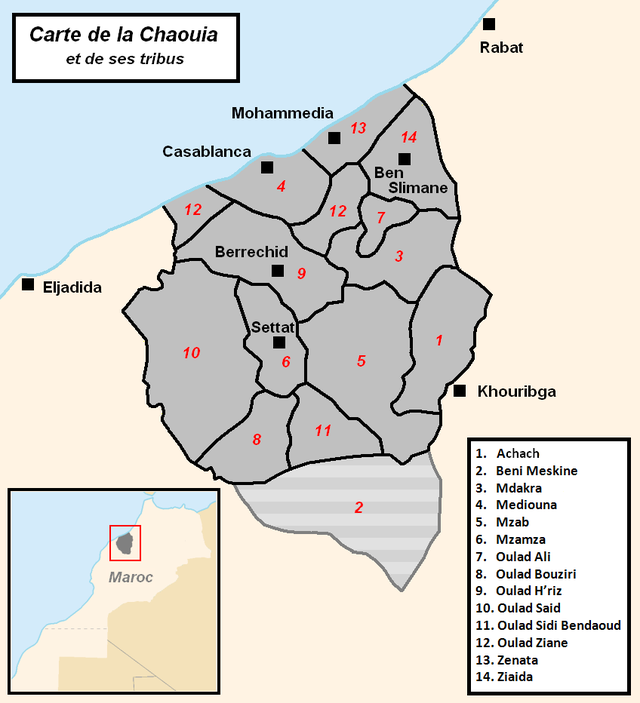Chaouia (Morocco)
Tribal confederation and historical region of Morocco From Wikipedia, the free encyclopedia
The Chaouia (Arabic: الشاوية, romanized: Shāwiyya) is a plain and historical and ethno-geographical region of Morocco in the historical region of Tamesna. It is bounded by the Oum er-Rbi' River to its southwest, the Cherrate River to its northeast, the plain of Tadla to the southeast and the Atlantic Ocean to the northwest. The region covers a land area of nearly 14 000 km2. The term also refers to a tribal confederation that traditionally inhabits the region.

Etymology
The word "Chaouia" means "Land of Chaouis", transliterated in French. "Chaoui" (Arabic: شاوي, romanized: shāwī) is a word meaning "possessors of sheep" or "shepherds".[1]
Geography
Geographically, the Chaouia can be divided into two sub-regions: low and high. The low Chaouia being the coastal part while the high Chaouia is further inland. Soils vary in fertility: The dark tirs[check spelling] is prized for its high yields and is found among the Mdhakra, Ouled Hriz and Oulad said. There is also the red hamri terra rossa.

Throughout Morocco's history, the Chaouia was famous for farming wheat and barley, which were exported in years of abundance from Casablanca, Fédala or Azemmour. Chaouia sheep was also prized for its wool, which was also exported to Marseille where it was known as wardigha in reference to one of the tribes in the interior.
Nowadays, the Chaouia is part of the Casablanca-Settat administrative region.[2][3][4]
History
Summarize
Perspective
Originally, the Chaouia was ruled by the Barghawata until it was annexed by the Almoravids,[5] depopulating the area.[6] After the Almohad ruler Abd al-Mu'min captured the town of Marrakesh in 1147, he encouraged the settlement of Bedouin Arab tribes in the area and the rest of the Moroccan coastal plains[6] which were largely depopulated after the Almoravid conquest,[6] including Banu Hilal, Banu Sulaym, and Banu Ma'qil,[7] which led to a further extension of Arabic and an increased importance of Arab elements in the power equation of Morocco,[6] to the point where no one could have ruled there without their co-operation.[8]

Portuguese colonists called the region Enxovía.[12] An undated letter sent from Sheikh Yahya ben Bulisbé (يحيى بن بلسباع) of the Shawiya to the King of Portugal indicates that the Sheikh cooperated with the Portuguese and that the sultans of Fes held tenuous authority in the region.[10][11]: 152
The Saadi Sultan Abu Marwan Abd al-Malik I Saadi occupied the region during the Battle of Alcácer Quibir and leveraged the mujahideen against his nephew Abu Abdallah Mohammed who had sought the support of the Portuguese.[11]: 152
In the early 20th century, the Chaouia carried out a strong rebellion against the French.[13] In 1907, the French bombarded Casablanca and entered the Chaouia region before extending their control over all of Morocco.[14] During the French protectorate, the Chaouia was part of the "Autonomous subdivision of Casablanca". It was then divided into three civilians controls : Chaouia-North (Casablanca), Chaouia-Center (Berrechid) and Chaouia-South (Settat).
Tribal composition
Summarize
Perspective


The Chaouia (or Shawiya) tribes come from a variety of Arab and Berber origins, although today they are linguistically Arabized.[15] A French survey of Moroccan tribes published in 1915 reported that all of these tribes claimed a pure Arab origin.[16]: 267 The Chaouia tribal confederation traditionally consists of 14 Arabic-speaking tribes:
| Tribe | Origin | Notes |
|---|---|---|
| Achach | Arab (Banu Sulaym)[16]: 157–190 | |
| Beni Meskin | Arab | Previously part of the Tadla confederacy, joined the Chaouia in the 19th century. |
| Mdakra | Arab (Ahlaf and Sabbah) and Berber (Hawwara)[16]: 117–156 | Merged with a Barghawata original group. |
| Mediouna | Berber (Zenata)[16]: 15–23 | |
| Mzab | Berber (Zenata)[15] | |
| Mzamza | Mainly Berber (Masmuda) origin, with some later Arab (Zughba) elements[16]: 266–267 | |
| Oulad Ali | Arab (Banu Ma'qil)[16]: 117–156 | |
| Oulad Bouziri | Berber (Sanhaja)[16]: 243–320 | |
| Oulad Hriz | Mainly Arab with Berber origins, due to subtribes[16]: 71–116 | |
| Oulad Saïd | Arab (Zughba, Banu Hilal)[16]: 191–242 | Settled in the region during the Marinid era |
| Oulad Sidi Bendaoud | Mainly Berber (Sanhaja)[16]: 243–320 | |
| Oulad Zyan | Arab (Zughba, Banu Hilal)[16]: 24–29 | |
| Zenata | Berber (Zenata)[16]: 30–44 | |
| Zyayda | Arab |
References
Bibliography
Wikiwand - on
Seamless Wikipedia browsing. On steroids.
